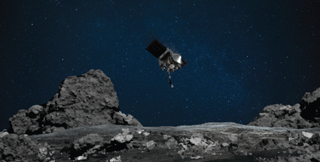
Space Highlights 2023
- 6th Dec 2023
- Author: Alex Thompson
2023 was a Lucy-JUICEy kind of year for space! From robotic missions to rocket launches and human spaceflight, here's a round up of some of the most notable events in the space calendar from the past year.
Robotic missions
The European Space Agency (ESA) launched a particularly game-changing mission in April with the JUpiter ICy moon Explorer (JUICE). The spacecraft will visit Europa, Ganymede and Callisto, three moons of Jupiter with an icy exterior that scientists hope could hold a liquid ocean interior. Any evidence of these potential oceans would further heighten the possibilities of life existing on these moons. JUICE will arrive at the Jovian system in 2031, with scientists at the University of Leicester amongst those set to study its findings.
India became the fourth country to land a spacecraft on the Moon, and the first to do so near its south pole, with the success of the Chandrayaan-3 mission. A follow on from its failed predecessor, Chandrayaan-3 consisted of a lander and a rover, touching down on 23 August. After completing its initial objectives, including a ‘hop’ on the lunar surface as a test for potential future return missions, the spacecraft was put into sleep mode on 3 September, failing to wake up again when prompted three weeks later.
Not to be left out, NASA launched its big mission of the year, Psyche, on 13 October. The craft will take a closer look at 16 Psyche, a metallic asteroid that scientists believe may be the exposed iron core of a protoplanet, stripped of its mantle and crust. Psyche will begin orbiting and studying its namesake asteroid in 2029.
2023 also saw spacecrafts arrive at their destinations, and even return home. NASA’s Lucy mission, launched in 2021, completed a flyby of 152830 Dinkinesh, making it the smallest main-belt asteroid ever visited by a spacecraft at just 790m in diameter. And the space agency’s OSIRIS-REx mission successfully returned a sample to Earth from asteroid 101955 Bennu. Following the competition of this primary goal, the spacecraft will now look to complete a flyby of another asteroid under the name OSIRIS-APEX.
Rocket launches
When it came to new rockets, the theme of the year was certainly private companies finding new ways to launch into orbit.
Space Pioneer launched a small satellite using its Tianlong-2 vehicle in April, making them the first Chinese private launch firm to launch into orbit using a liquid propellant rocket. Three months later the same site, the Jiuquan Satellite Launch Center, saw another first as LandSpace’s Zhuque-2 became the first rocket to reach orbit using a liquid methane propellant.
One of the competitors LandSpace had to see off for this honour was SpaceX’s Starship, which had a very mixed year. The tallest, heaviest and most powerful launch vehicle ever created, the 121 metre, 5 million kilogram rocket had its first test flight in April, ending four minutes later with the deliberate destruction of the vehicle after the two stages failed to separate. A second test flight took place in November was more successful, with the stages separating before the first stage exploded during the boostback burn and signal was then lost with the second so they declared it lost.
Human spaceflight
Two new world records (errr, space records) were set this May!
On 25 May, Virgin Galactic’s Unity 25 flight sent six people above 80 kilometres high - the United States’ definition of the start of space (but below the 100 kilometre mark used for the Karman line’s definition). Using the former, it means a record twenty people were in space for those few moments, with three astronauts onboard on the Chinese Tiangong Space Station and an additional eleven on the International Space Station (seven from Expedition 69 and four from the commercial Axiom programme).
Five days later, and an additional three astronauts boarded Tiangong (readying for crew rotation), meaning another record of seventeen people in orbit simultaneously was set between the two space stations.
One of the ISS Axiom astronauts at this time was Peggy Whitson, who further extended her American record of 675 total days in space by an additional eight days. Also on this mission was Rayyanah Barnawi, who became the first ever female Saudi astronaut and the first Arab woman in space.
In other exciting space firsts, Sultan Al-Neyadi became the first Arab to complete both a spacewalk and a six-month mission on the ISS. And Andreas Mogensen returned for a second ISS mission in August, becoming the first non-American to pilot a SpaceX Crew Dragon spacecraft.
We hoped you enjoyed our trip down memory lane - join us again very soon as we look ahead to space in 2024!
Full references / credits:
(Banner image) OSIRIS-REx completed stage one of its mission. Credit: NASA
(1a) JUICE will explore Jupiter’s icy moons. Credit: ESA
(1b) Psyche will reach its destination in 2029. Credit: NASA
(2) Starship had lift-off with two test flights this year. Credit: SpaceX
(3) Rayyanah Barnawi became the first Arab woman in space. Credit: Axiom Space





